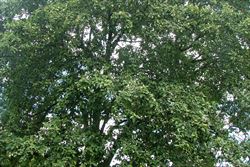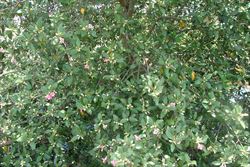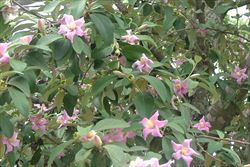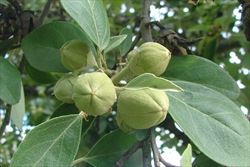Click on images to enlarge

habit of large tree (Photo: Sheldon Navie)

habit in flower (Photo: Sheldon Navie)

bark on main trunk (Photo: Sheldon Navie)

flowers and leaves (Photo: Sheldon Navie)

leaves (Photo: Sheldon Navie)

close-up of leaf (Photo: Sheldon Navie)

close-up of flower bud (Photo: Sheldon Navie)

flower (Photo: Sheldon Navie)

young fruit (Photo: Sheldon Navie)

close-up of immature fruit (Photo: Sheldon Navie)

mature fruit (Photo: Sheldon Navie)

close-up of mature fruit with seeds (Photo: Sheldon Navie)
Scientific Name
Lagunaria patersonia (Andrews) G. Don
Synonyms
Hibiscus patersonia AndrewsLagunaea patersonia (Andrews) SimsLagunaea squamea Vent.Lagunaria patersonia (Andrews) G. Don subsp. patersonia Lagunaria patersonia (Andrews) G. Don var. typica DominLagunea patersonia (Andrews) Pers.Solandra squamea (Vent.) Poir.
Family
Malvaceae (New South Wales, Victoria, South Australia and Western Australia)Bombacaceae (Queensland)
Common Names
cow itch tree, cowitch tree, cowitchtree, itchy powder tree, Norfolk hibiscus, Norfolk Island hibiscus, pyramid tree, Sally wood, white oak, whiteoak, whitewood
Origin
Native to Norfolk Island and Lord Howe Island.
Naturalised Distribution
This species is becoming naturalised is many parts of southern Australia (i.e. near Perth in south-western Western Australia, in south-eastern and southern South Australia, in the coastal districts of New South Wales and in southern Victoria).
Notes
Norfolk Island hibiscus (Lagunaria patersonia) is regarded as an environmental weed or potential environmental weed in some parts of New South Wales, Victoria, South Australia and Western Australia. This species has escaped gardens and invaded native vegetation, particularly in coastal areas.
In Western Australia, Norfolk Island hibiscus (Lagunaria patersonia) has invaded coastal cliff tops and disturbed natural vegetation in the Swan River estuary and Augusta area. In New South Wales it is listed as an environmental weed in the North Coast and Central Coast regions. It is also regarded as an environmental weed in the Geelong region in southern Victoria, and is recorded as a weed in Marino Conservation Park in South Australia.
Note: Until recently, this plant went by the name Lagunaria patersonia subsp. patersonia, while a very similar plant from coastal Queensland (i.e. the Queensland pyramid tree or Queensland white oak) went by the name Lagunaria patersonia subsp. bracteatus. However, recent research has indicated that the Queensland plant should be regarded as a separate species (i.e. Lagunaria queenslandica).
The Queensland pyramid tree (Lagunaria queenslandica) can be distinguished from Norfolk Island hibiscus (Lagunaria patersonia) by its cup-shaped floral bracts (i.e. cupular epicalyx), which are quickly shed (i.e. caducous).

